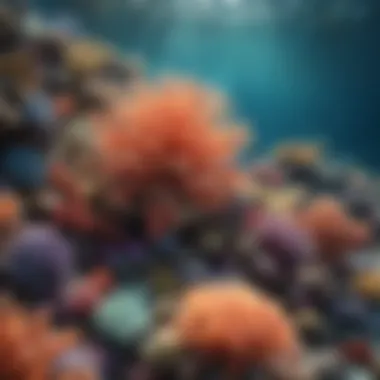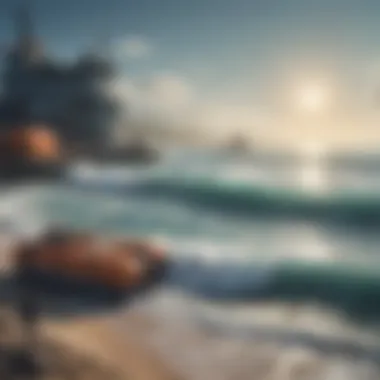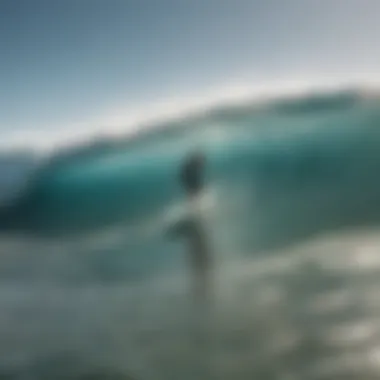The Ocean Cleaning Project: A Comprehensive Overview


Intro
In today's world, the plight of our oceans has become a critical topic of discussion among environmentalists, surfers, and marine enthusiasts alike. The appeal of vast blue waters is often overshadowed by the grim reality of pollution choking marine ecosystems. Initiatives aimed at ocean cleaning not only target trash removal but also seek to foster a culture of awareness and responsibility among communities that love the surf. Understanding the dire need for such projects is key for anyone who enjoys the ocean, whether you're riding waves or conducting research beneath its surface.
The challenge of ocean pollution isn't merely a technical issue; it involves social, economic, and cultural dimensions. Polluted waters affect fish populations and, in turn, the livelihoods of those who rely on them for food and income. The impacts ripple outwards, touching surf culture and lifestyle. Collaborative efforts in clean-up projects can bolster community ties, uniting surfers, environmentalists, and local businesses to advocate for sustainable practices.
As we navigate through the depths of this article, we will encounter innovative technologies that promise to enhance cleanup efficiency, the roles individuals and organizations are playing to tackle pollution head-on, and how the surfing community can contribute to these vital efforts. By sharing insights and success stories, we aim to inspire a sense of stewardship over our ocean resources. This is more than just about cleaning beaches; it's about ensuring that future generations can enjoy the ocean and the surf that comes with it.
Surfboard Reviews
Types of Surfboards: An Overview
When it comes to surfing, the choice of equipment plays a crucial role in both performance and enjoyment. Different types of surfboards cater to various styles and skill levels. Here’s a brief rundown of some common types:
- Shortboards: These are typically around 5’8" to 6’6" long and favored by advanced surfers for their agility and responsiveness in powerful waves. They serve as a go-to for those looking to perform advanced maneuvers and tight turns.
- Longboards: Generally spanning over 9 feet, longboards offer stability and ease of paddling, making them ideal for beginners or those who prefer a laid-back cruising style. Though less maneuverable than shortboards, they allow for a unique riding experience.
- Fish Boards: With a wider shape and split tail, fish boards are designed for speed and can perform well in smaller, choppier waves. They bridge the gap between short and longboards, giving surfers an adaptive option.
Each board type holds unique characteristics, which means picking the right one can be as personal as choosing a favorite pair of shoes. The ocean's dance may transform, and having the right surfboard will help navigate its rhythm.
Best Surfboards for Beginners and Pros
Finding the right board can be a game-changer for surfers at all skill levels. Here’s a closer look at some recommended surfboards to consider:
For beginners:
- Soft-top Surfboards: Soft tops provide a gentler introduction to surfing. Their buoyancy helps in catching waves, while the soft surface minimizes the risk of injury during falls. Brands like Wavestorm and Catch Surf usually have a good selection.
- Longboards: As mentioned before, longboards are excellent for learning. The stability they offer makes it easier for novice surfers to practice balance and paddling technique. The Malibu or NSP longboards are often recommended for budding enthusiasts.
For experienced surfers:
- High-Performance Shortboards: The Lost Rocket or Rip Curl’s Search Shortboard are ideal for those wanting to push their limits and explore dynamic surfing techniques. These boards provide responsive handling, crucial for advanced maneuvers.
- Hybrid Boards: These blend different features and can adapt well to various wave conditions. They are suitable for skilled surfers looking for versatility. The Boardworks Frog is a great example of a high-performing hybrid surfboard.
As surfers, we play a crucial role in protecting the environments we cherish. Selecting the right board that resonates with our skills and style enhances not just individual experiences but contributes to a more sustainable surf culture that protects our oceans for future enjoyment.
Prelims to Ocean Pollution
Ocean pollution is a pressing issue that transcends simple environmental concern; it is intricately linked to our health, economies, and ecosystems. This problem emerges from a myriad of sources, including industrial waste, plastic debris, and agricultural runoff. Understanding ocean pollution is vital not just for marine life but also for those who thrive on healthy oceans, such as surfers, marine biologists, and coastal communities. It’s no longer about ignoring the tide; it’s about acknowledging the ripples caused by human activity and taking action.
To put it plainly, every piece of trash, every ounce of chemicals that ends up in the ocean, creates a cascade of effects that impact every water-borne creature and, by extension, ourselves. Surfers, who depend on clean waves and healthy ecosystems, are often on the frontline—experiencing the unfiltered reality of pollution firsthand. They can serve as vital advocates for ocean health. Bringing this topic to light not only raises awareness but also motivates concrete action towards cleanup initiatives.
Defining Ocean Pollution
Ocean pollution can be defined broadly as any contaminant introduced into the marine environment that causes harmful effects. This encompasses everything from visible items like plastic bags and bottles, to invisible pollutants such as heavy metals and chemicals. When considering what qualifies as pollution, it’s crucial to recognize its varied forms:
- Solid Waste: Mainly plastics, which contribute to the infamous Great Pacific Garbage Patch and threaten marine animals.
- Chemical Contaminants: These can come from agricultural runoff, like pesticides or fertilizers, which eventually make their way to the sea.
- Nutrient Pollution: Excessive nutrients cause harmful algal blooms that deplete oxygen and can lead to dead zones, wreaking havoc on local marine life.
Recognizing these elements helps us grasp the scale of human impact on the oceans.
Statistics and Current State
The statistics surrounding ocean pollution are as sobering as they are alarming:
- Approximately 8 million tons of plastic waste end up in the oceans each year.
- 100,000 marine mammals and more than 1 million sea birds die annually due to plastic pollution, highlighting the catastrophic effect on wildlife.
- Current estimates suggest that almost 50% of the world’s coral reefs are dead or dying, due in large part to pollution and climate change impacts.
These numbers clear indicate that ocean pollution isn't a distant problem; it's immediate, it's personal, and it requires urgent attention. Each stat is a call to action, underscoring the necessity for innovative cohesion among surfers, scientists, and community members to push for sustainable practices and holistic cleanup approaches.
"The health of our oceans signifies the health of our planet. When we protect our oceans, we protect ourselves."
The vivid reality of ocean pollution serves as a backdrop for understanding the need for proactive cleanup endeavors. As we delve further into this article, we will examine the positive strides and innovative solutions being proposed to heal our oceans and protect our cherished surf culture.
Understanding the Impacts of Ocean Pollution


Ocean pollution is not just a troubling headline, it’s a crisis that affects us all—from marine creatures to those who enjoy the surf and turf lifestyle. Understanding the impacts of this pollution is imperative to grasping the full scale of the environmental challenge we face today. It goes beyond oil spills and plastic islands; it touches on biodiversity loss and human health risks, influencing both recreation and the economy tied to coastal regions.
The degradation of our oceans ushers in a cascade of effects that can disrupt entire ecosystems and human existence alike. When we contemplate the far-reaching consequences of ocean pollution, we see a colorful tapestry of life losing its vibrancy, as marine flora and fauna struggle to survive amid pollution stress. But the implications reach deeper. They affect our well-being, our communities, and for many, even the very culture surrounding surfing.
Effects on Marine Life
Marine life is like a fine meal, if the ingredients are spoiled, the entire dish goes awry. Pollutants such as plastic waste, heavy metals, and chemicals can be fatal to many species that call the ocean home. Fish ingest plastic microbeads that not only affect their health but also make their way up the food chain. This is not a mere hypothetical; it’s a pressing reality. Coral reefs, often heralded as the rainforests of the sea, are suffering from bleaching and acidification. This not only destroys the habitat of diverse marine species but also affects fishermen who rely on healthy fish populations for their livelihood.
Furthermore, there are long-lasting repercussions. As various oceanic habitats shift or degrade, species that rely on specific conditions struggle to adapt. The decline of certain fish populations has reverberated through ecosystems and human economies, showing just how interconnected these systems truly are.
"If the oceans die, our future generations may never know their wonders, and that’s a future none of us should want to face."
Impact on Human Health
When we cast our nets into the ocean, we’re not just catching fish, we’re also catching potential health risks. Contaminated seafood can be a direct line to serious health conditions for consumers. High levels of mercury in big fish like swordfish and shark pose dangers that can affect neurological development in children and adults alike. Recreational activities such as swimming, surfing, or even just wading in polluted waters can lead to diseases and infections from harmful pathogens.
Adding fuel to the fire, harmful algal blooms, frequently exacerbated by nutrient runoff, release toxins that can affect not only aquatic life but also those who interact with the water. The closer the community is to these waters, the more significant the risk. This threat to public health cannot be overstated; it raises alarms for healthcare systems and emphasizes the need for stringent pollution control measures.
Consequences for Surf Culture
Surfing isn't just a pastime, it's a culture—a way of life that connects enthusiasts to the ocean. However, the increasing pollution threatens this bond and changes the very essence of surf culture. Surf breaks that were once pristine are now littered with debris, affecting both the quality of the waves and the harmony surfers feel in the water. Clean, healthy oceans are essential for both the enjoyment and safety of surf activities; pollution undermines this.
Moreover, the aesthetic and spiritual connection surfers have with the sea can become tainted. Waves that are influenced by local pollution can lead to a decline in the surf community's joy, as they grapple with the reality that their beloved waters are under siege. Preserving surf culture isn't simply about enjoying the ride; it entails advocating for ocean health and sustainability.
Mechanisms of Ocean Cleanup
Cleaning the ocean isn't just a noble aspiration; it's a necessity. The mechanisms behind ocean cleanup involve various approaches that aim to address the pervasive pollution issue affecting our marine environments. By diving into the different strategies employed, we can comprehend their significance and necessities in the global fight against ocean pollution. The importance of effective cleanup methods cannot be overstated. They not only directly impact the health of marine life but also cater to human welfare and the sustainability of coastal communities.
Technological Innovations
Autonomous Vessels
Autonomous vessels play a notable role in maritime cleanup initiatives. Equipped with advanced technology, they can navigate the waters without human operators. This is a game-changer because they can work in hard-to-reach areas or during inclement weather.
A key characteristic of these vessels is their ability to operate consistently over long durations, giving them an edge in performing underwater tasks. This capability makes them a beneficial choice for rapid ocean pollution response since their deployment can often be quicker than traditional ships requiring crew. An essential feature of autonomous vessels includes their capacity to collect vast amounts of debris while minimizing disturbances to the marine ecosystem. However, a potential disadvantage is the high initial cost of development and maintenance.
Robotic Solutions
Robotic solutions provide another layer of depth in ocean cleanup methods. Through various designs, they are engineered to gather waste, from plastic to larger debris. These robots tend to have high maneuverability, which allows them to reach areas that larger vessels might struggle with.
One key characteristic of robotic solutions is their ability to operate autonomously in areas with high pollution concentrations, meaning they can work around-the-clock without the need for supervision. This aspect makes them a popular choice among cleanup projects. A unique feature of these robots is their ability to analyze environmental conditions in real-time, which provides data that can be invaluable for future initiatives. However, they do pose a risk if they malfunction, which can lead to additional challenges in cleanup efforts.
Bioremediation Techniques
Bioremediation techniques harness biological processes to remove pollutants from the environment. This approach involves utilizing microorganisms or plants to break down toxic substances. It’s an innovative method that not only cleans but also restores the ecosystem.
A prominent characteristic is the natural ability of these organisms to assimilate harmful substances. This makes bioremediation a sustainable and beneficial choice for longer-term ocean health. A notable feature of bioremediation techniques is their minimally invasive nature, which means the ecosystem remains relatively undisturbed. However, effectiveness can vary based on specific pollutants' nature, as some might resist breakdown or require additional treatment.
Community-Led Initiatives
Community-led initiatives are crucial for fostering local involvement and creating a significant impact on ocean cleanup. These grassroots efforts enable individuals to band together and organize beach cleanups, awareness campaigns, or educational programs. The direct involvement of local communities ensures that the needs of specific areas are met while creating an empowering environment for participants. Such initiatives not only clean the shores but instill a sense of responsibility toward the ocean within communities.
Legislative Frameworks
Legislative frameworks play an important role in regulating and supporting ocean cleanup efforts. Governments and organizations can enact policies to promote sustainable practices and allocate funding to cleanup projects. These frameworks help set legal standards for marine conservation, incorporating fines and penalties for pollution, which can serve as a deterrent for harmful practices. Sound legislation can stimulate community engagement and ensure that cleanup efforts are backed by a solid foundation, contributing toward a healthier ocean for generations to come.
Case Studies of Successful Ocean Cleanup Projects
Examining successful ocean cleanup projects offers invaluable insights into effective strategies and tangible outcomes. These case studies serve as proof that not only can initiatives make a difference, but they can also inspire broader movements toward ocean health. When looking at ocean cleanup efforts, we gain a multifaceted understanding of what works, the hurdles faced, and the collaborative spirit that often drives these endeavors forward.


The Ocean Cleanup Project
The Ocean Cleanup Project has made waves—literally and figuratively—since its inception. Founded by Boyan Slat in 2013, this initiative targets the Great Pacific Garbage Patch, one of the largest accumulations of ocean plastic globally. Unlike traditional background cleanup methods, this project employs a passive system that utilizes the natural ocean currents to gather plastic debris.
A key highlight of the Ocean Cleanup Project is its innovative design. The system consists of floating barriers that funnel debris into a center ‘catchment area’. From there, the plastic is collected and transported back to shore for proper recycling. In 2021, the project successfully deployed its first operational cleanup system, known as System 002, which showed promising results, collecting tons of plastic in less time than expected.
Notably, this project doesn’t just aim to clear debris; it’s about raising awareness and demonstrating feasible solutions. By spotlighting the issue of ocean pollution, it engages individuals, researchers, and policymakers alike to take action.
Gyres Institute Initiatives
The 5 Gyres Institute stands as a pioneer in coastal and oceanic research regarding plastic pollution. Its work is particularly crucial in addressing the five major ocean gyres where plastic accumulations are most prevalent. Instead of just focusing on cleanup, 5 Gyres emphasizes education and prevention—encouraging communities to rethink their relationship with single-use plastics and strive towards reducing waste at the source.
Their expeditions often culminate in rigorous data collection efforts, providing a scientific basis for advocacy. For example, the Institute’s research has directly influenced policy changes in various states, leading to bans on plastic bags and straws. Furthermore, their community engagement programs highlight the connection between ocean health and human activity, emphasizing that every small choice can have a broader impact.
Local Community Actions
Communities across the globe have demonstrated that change often starts at the grassroots level. Local actions can lead to significant results, showcasing that even small efforts can culminate in substantial victories. Whether it’s beach cleanups or educational workshops, the commitment of local volunteers plays an essential role in the battle against ocean pollution.
- Beach Cleanups: Organized cleanups not only clear debris but also foster a sense of community. Participants gain hands-on experience regarding the scale of ocean pollution, solidifying the importance of individual and collective responsibility.
- Educational Workshops: Empowering local residents with knowledge equips them to relay information to others. Workshops can cover topics such as recycling properly, reducing plastic usage, and advocating for local policies.
- Partnerships: Local businesses often collaborate with environmental organizations, providing resources and popularity for events. This synergistic approach amplifies efforts and helps bring in new participants.
Simply put, local community actions illustrate that while ocean cleanup can occur on a broader scale, small, concentrated efforts are equally vital. The involvement of passionate individuals fuels the drive towards a cleaner ocean.
"The ocean is not just a resource; it's a lifeline for countless species, including us. Every project, every cleanup, no matter how small, is part of the fight for its survival."
Engaging the Surf Community in Ocean Cleanup Efforts
Surfers enjoy a unique relationship with the ocean. It’s not just about catching waves but also about appreciating the vibrancy of marine environments. Engaging the surf community in ocean cleanup efforts is thus crucial. It attracts attention to the pressing issue of pollution while also leveraging the passion surfers have for the sea. When surfers immerse themselves in cleanup initiatives, they not only contribute to healthier oceans but also deepen their connection to the water they love.
Raising Awareness Among Surfers
Awareness is the first step toward action. Many surfers might not realize the extent of ocean pollution affecting the waves they cherish. Distributing informative materials at surf shops, local surf contests, and beach events can shed light on the issue. Engaging content, such as infographics about the impact of plastic pollution on marine life, can spark interest. Workshops featuring marine biologists can educate surfers on how pollution affects water quality and wave conditions. Knowledgeable voices make a difference; the surf community can rally around these issues if they understand the stakes.
Collaboration with Environmental Organizations
Partnerships with environmental organizations can amplify efforts to clean beaches and oceans. Surf clubs can align with groups such as Surfrider Foundation or Ocean Conservancy to implement beach cleanup days. These collaborations not only unify efforts but also pool resources and expertise. Joint events raise visibility and can draw local media attention, highlighting the crucial role that surfers play in environmental stewardship. Building a network can also help spread the message across different geographic areas, creating a ripple effect in the movement towards cleaner oceans.
Sustainable Surf Products
Surfers are in a prime position to influence the market for sustainable surf products. As awareness of ocean pollution grows, so does the demand for environmentally friendly boards and accessories. Brands like Firewire and Greenlight Surf Supply have surged in popularity, offering surfboards made from recycled materials or sustainably sourced wood. Promoting these products in the surf community highlights how individual choices contribute to broader environmental efforts. When surfers opt for sustainable products, they signal to manufacturers that there’s a market for environmentally responsible surfing gear.
"The ocean is a big part of who we are as surfers. Protecting it should be our priority." - Anonymous Surfer
In summary, engaging the surf community is not merely beneficial; it is necessary. By raising awareness, collaborating with environmental groups, and choosing sustainable products, surfers can lead the charge in the fight against ocean pollution. Their unique position allows them to be effective advocates for change. This kind of grassroots movement can set a precedent, inspiring others to follow suit in protecting this invaluable resource.
Challenges and Barriers to Successful Cleanup
The topic of challenges and barriers pertaining to ocean cleanup is not just relevant but essential for understanding the broader context of marine restoration. Every grand plan to clean up the oceans faces hurdles that can derail even the most well-intentioned efforts. By dissecting these challenges, stakeholders can gain deeper insights into what needs fixing and how to collaborate effectively. The success of ocean-cleaning projects hinges on addressing these barriers, thereby enabling a sustainable approach that resonates across communities, including the surfing crowd.
Funding and Resource Limitations
Many times, the heart of the matter in cleanup efforts comes down to money. Projects can start with all the enthusiasm possible, only to grind to a halt when the funds dry up. In the world of ocean cleaning, funding isn't merely a matter of securing grants or public contributions; it involves crafting a viable business model. Without proper financial backing, lofty projects face serious reality checks.
Moreover, locating the necessary resources—be it innovative technologies or manpower—presents another layer of complexity. For instance, emerging technologies such as autonomous vessels or advanced data-collection tools, while game-changing, often come with hefty price tags. This makes it crucial to build partnerships with both public and private entities to pool resources effectively.
"Funding isn't just a number; it's the lifeblood that keeps our ocean-cleaning efforts afloat."
Political and Legal Obstacles
Navigating the political landscape can often feel like swimming upstream. Different governments and jurisdictions have varying regulations that can hinder cleanup operations. Environmental laws, procedural red tape, and sometimes conflicting priorities can set the scene for friction rather than fluidity in collaboration.


Legal challenges often arise due to jurisdictional boundaries that can complicate multi-national cleanup efforts. Various stakeholders may lack alignment, creating opportunities for delays and disputes. It’s imperative that advocacy groups work hand-in-hand with legal experts to streamline these processes so that cleanup operations can go off without a hitch. Ultimately, engaging policymakers is vital to cultivating a supportive legal environment.
Public Engagement Issues
Their involvement or indifference can make or break a cleanup project. Public apathy towards ocean pollution often stems from a lack of awareness or misconceptions about the impact of pollution on marine life and, ultimately, on human health. Effective engagement strategies are necessary to bridge this gap.
Communicating the significance of ocean health to diverse audiences—surfers, local communities, and even casual beachgoers—becomes crucial. Campaigns can leverage different platforms, from social media to community meetings, to foster a sense of shared responsibility. Utilizing art, storytelling, or even educational programs makes the topic resonate more and allows community members to feel invested in cleanup efforts.
Addressing these challenges in a holistic manner is the only way forward. By prioritizing funding, smoothing out legal hurdles, and enhancing public engagement, ocean cleanup projects can move from conceptual stage to impactful action in a sustainable way.
Future of Ocean Cleaning Projects
Looking ahead, the future of ocean cleaning projects stands on the edge of innovation and necessity. The vast oceans, once thought to be insurmountable in their capacity to absorb our human impact, are now revealing the fragility of marine ecosystems. As pollution burgeons, so too does the urgency for practical solutions. This section delves into the elements driving change in ocean cleanup initiatives, highlighting cutting-edge technology, sustainability efforts, and the significant role of youth engagement as pivotal catalysts for a healthier marine environment.
Emerging Technologies
Emerging technologies are revolutionizing the landscape of ocean cleanup endeavors. From autonomous drones sweeping through the waves to sophisticated software analyzing ocean currents, it's inspiring to see what creativity and technology can achieve together. For instance, The Ocean Cleanup, a Netherlands-based organization, is at the forefront with their robotic systems specifically designed to intercept plastic debris. Their ongoing project in the Great Pacific Garbage Patch showcases how large-scale endeavors can utilize engineering feats to tackle global issues.
Noteworthy innovations also include:
- Floating barriers designed to guide debris into central collection points, enabling efficient removal.
- AI-based monitoring systems, which use data to model the movement of waste and help direct cleanup efforts.
- Biological solutions, such as specialized bacteria that can degrade plastics into harmless substances, are another avenue worth exploring.
These technological advancements are not just about cleaning; they can transform how communities perceive waste management and environmental responsibility.
Long-term Sustainability Initiatives
Sustainability isn't merely a buzzword—it's a necessary approach if we want our efforts to yield lasting results. Long-term sustainability initiatives focus on maintaining the health of marine ecosystems beyond the immediate cleanup. These initiatives include promoting responsible plastic use, advocating for regulatory policies that limit waste generation, and developing biodegradable alternatives to common toxins found in the ocean.
Key components of long-term sustainability strategies are:
- Education programs aimed at teaching communities about the implications of pollution.
- Partnerships with industries that manufacture eco-friendly products, reducing the influx of pollution into marine environments.
- Community engagement, encouraging citizens to participate in local cleanup activities and stewardship initiatives, ensuring that the momentum for maintaining cleaner waters continues.
By integrating these elements, we can build a more resilient ocean, benefiting marine life and coastal communities alike.
Role of Youth and Education
Engaging the youth in ocean cleaning efforts is crucial, as they are the stewards of tomorrow. Their capacity to adopt new ideas and inspire others cannot be underestimated. Educational initiatives have seen an upswing, providing young people with knowledge about ocean health and hands-on experiences in environmental care. Programs that leverage the enthusiasm of younger generations have a ripple effect, spreading awareness rapidly.
Ways to engage youth include:
- School programs that incorporate ocean cleanup topics into curricula, fostering interest from an early age.
- Volunteer opportunities where young people can participate in community beach cleanups, gaining practical experience and making tangible contributions.
- Social media campaigns designed to raise awareness and encourage youth to share their efforts, creating a broader dialogue around marine conservation.
Inculcating a sense of responsibility among young people fosters a culture of care. As they become aware of the stakes involved, the motivation to act—for their oceans and their future—can lead to powerful movements.
"The best way to predict the future is to create it." – Peter Drucker
As we forge ahead, the marriage of excitement, educational pursuit, and technological advancement provides a pathway that promises a healthier ocean. The fusion of these elements has the potential not just to clean the oceans but to reshape our relationship with them, ensuring that the waters that cradle our surf are preserved for generations to come.
Culmination: The Path Forward for Ocean Health
Addressing the future of ocean health is more than an aspiration; it's an imperative that calls for concerted efforts across communities, industries, and governments. As the article highlights, the complex relationship between ocean pollution, marine life, and human activity underscores the urgency for collaborative action. Ocean cleaning initiatives not only aim to restore ecological balance but also foster community involvement, which is crucial for sustainable development within coastal areas.
The key elements of this path involve embracing innovative solutions to cleanup efforts, ensuring long-term sustainability initiatives, and engaging younger generations through education. Each of these factors serves as a pivotal part of the broader strategy to enhance ocean health and protect our surf culture.
Summary of Key Points
- Ocean pollution impacts biodiversity and human health alike, necessitating effective cleanup solutions.
- Technological innovations such as autonomous vessels and bioremediation techniques are at the forefront of tackling pollution.
- Community-led initiatives play a critical role in raising awareness and promoting active participation.
- Collaboration between surfers and environmental organizations is essential for meaningful action.
- Future projects must consider youth engagement and education to instill a lasting ethos of stewardship.
Call to Action
This is the time to step into action. Surfers, instructors, beach lifeguards, and marine biologists—your involvement can make a tangible difference:
- Get Involved: Join local cleanup events or start your own initiative in your community. Every effort counts, no matter how small.
- Advocate: Use your platform to speak on the significance of ocean health. Share insights and findings from this article with friends and family.
- Educate: Engage youth in discussions on environmental stewardship. Host workshops or talks that raise awareness about the state of our oceans.
- Support Innovations: Back environmentally friendly products and services that promote sustainability in the surfing community.
By taking these steps, we contribute to the creation of a healthier ocean, fostering conditions for marine life to thrive, and ultimately ensuring that generations of surfers can enjoy the surf culture we hold dear.















